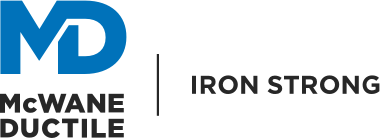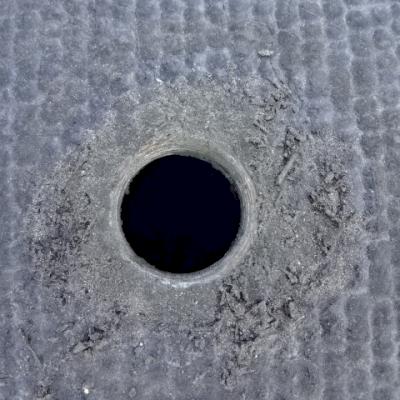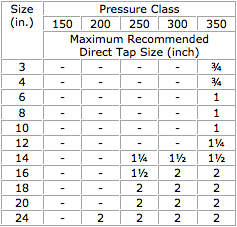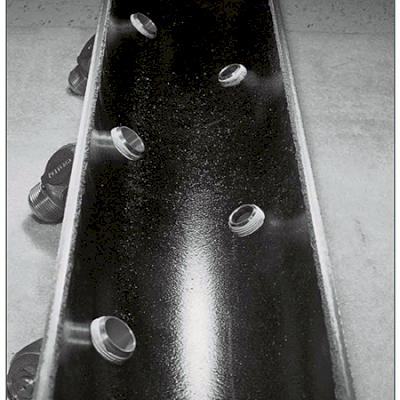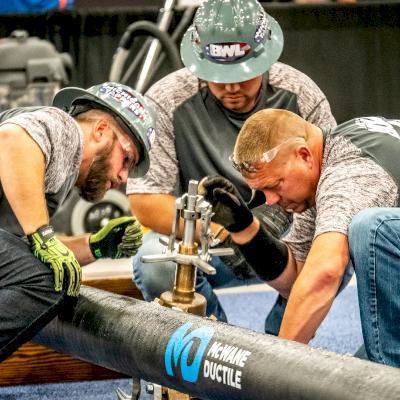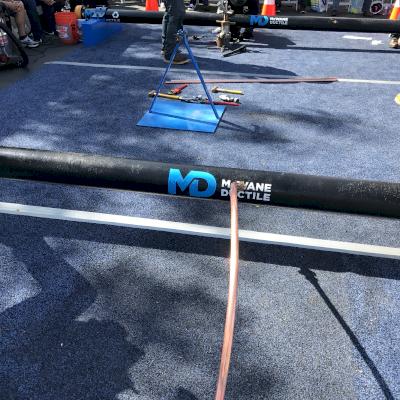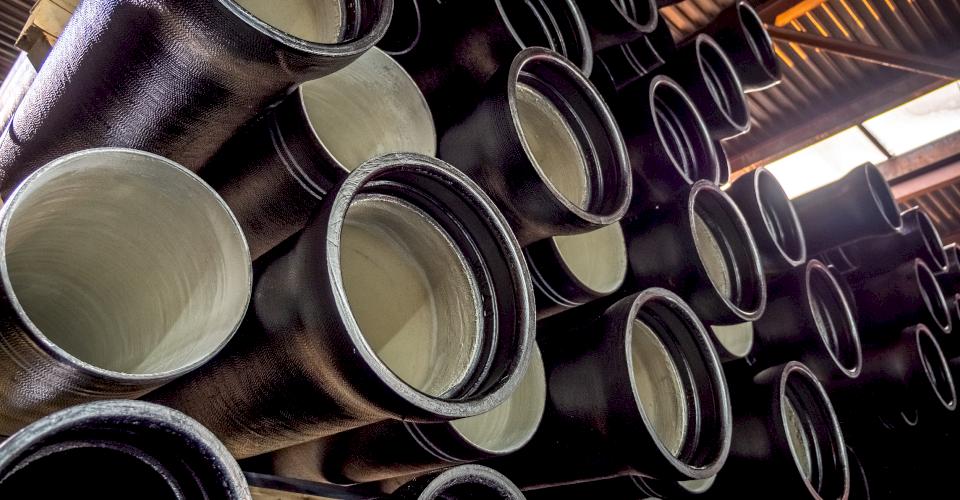With Ductile iron pipe (DI pipe), typical service taps can be installed directly into the wall of the pipe, which is called “direct tapping.” The ability to use direct tapping eliminates the need for tapping saddles. And the ease at which DI pipe can be "hot tapped" helps avoid the issue of unhappy consumers because their service and pressure are not impacted by the addition of a new tap. The waterworks community frequently asks us, “How big of a tap will DI pipe allow?” The simple, most conservative response, not having interrogated the user as to their DI pipeline particulars, would be as follows:
- 3-inch and 4-inch pipe ─ ¾ inch
- 6-inch through 10-inch pipe ─ 1 inch
- 12-inch thorough 16-inch pipe ─ 1 ¼ inch
- 24-inch and Up pipe ─ 2 inch
This would be the most understated response to the minimum tap size, based on pipe size only.
See a video below of the annual tapping competition at AWWA’s Annual Conference and Exhibition (ACE) where 8-inch Pressure Class 350 and Thickness Class 52 is used during competition.
Testing and Recommendations
Digging a little deeper into this subject, we must first establish that the installer has made adequate provisions to perform a direct tapping procedure following the tapping machine and pipe manufacturers detailed instructions and must provide a serviceable tap with sufficient threads.
Regarding direct tap testing, the industry relies on the Ductile iron Pipe Research Association (DIPRA) for reliable recommendations concerning the direct tapping of DI pipe. The testing requirements are based on the minimum wall thickness allowed by ANSI/AWWA C151/A21.51. Direct taps are installed and pressurized to 500 psi, which is a rather extreme pressure as typical service lines have working pressure that are much less. Based on DIPRA’s testing, the maximum recommended tap size for pressure class DI pipe by class and pipe size can be found in the following chart:
Extensive testing by DIPRA has determined the lowest number of full thread engagements was 1.26 while maintaining a watertight seal at 500 psi. Contrary to brass manufacturers' recommendations, which rely heavily on addition threads to strengthen their position in DI pipe.
It should be noted that all classes of DI pipe 24-inch and larger are suitable to be direct tapped for up to 2-inch corporation stops. The cut off at 2 inches was chosen as most tapping machines used to direct tap pressurized mains are limited to 2 inches in size.
To complete the analysis of direct tapping DI pipe, it is essential to also look at the type of corporation thread being utilized such as Standard Tapper Threads (IP), or Corporation Stop Threads (CC), and charting the wall thickness required for a given tap size. Further allowing the user to determine the appropriate wall thickness/Class of DI pipe needed to achieve the desired number of threads. To perform this comparison, a helpful chart can be found in McWane Inc.'s Pipe Economy on page 230.
For helpful information on the difference between pressure class and thickness class of DI pipe, check out this Iron Strong Blog by my colleague, Jeremy Gwin.
In addition, it would be appropriate to have the dimensions chart available as a reference. This chart will allow the user to determine the wall thickness required to achieve the correct tap size and number of threads necessary to complete the tap. This chart can be found by visiting the McWane Ductile Learning Center on our website and by clicking this link.
Effective Direct Tapping
Direct tapping DI pipe, whether utilizing Pressure Class or Special Thickness Class pipe, can be accomplished effectively with the use of various types of tapping machines offered in today’s waterworks market.
Tapping costs for services or future connections is done most economically and reliably on DI pipe because of the iron’s inherent strength. This strength allows services to be tapped and threaded directly into the pipe wall itself without the need for expensive saddles that require additional material and labor costs. Additionally, DI pipe can be easily and quickly tapped with minimal equipment wear and tear due to the graphite content in the iron matrix.
It should also be noted that direct tapping DI pipe is the most effective method in installing a service connection both under pressure as well as prior to pressurizing the main. By no means do the following comments replace sound judgment and may require adjustment in the field based on changing site conditions.
Keep in mind, with PVC pipe, there are limitations. AWWA C605, the installation standard for PVC pipe, specifically restricts direct tapping to 12-inch and smaller pipe that has a DR of no more than 18 and suggests, “...a reduction of line pressure during tapping,” when possible (2 and 3).
For more information and recommendations on direct tapping DI pipe or any specific DI pipe installation needs, please reach out to your local McWane Ductile Sales Representative.
Also, our Sales Operations Group can be a valuable resource in assessing appropriate pipe applications for all your DI needs, from preliminary design, material specifications, and field recommendations concerning installing and testing the appropriate DI system to meet the requirements of your specific project.
Check Out All Our Digital Offerings
- More articles and videos from our Iron Strong Blog
- The McWane Pocket Engineer
- Engage with us on LinkedIn
- Follow us on Facebook
- Follow us on Twitter
Sources:
- Ductile Iron Pipe Research Association, “Frequently Asked Questions – Tapping,” https://www.dipra.org/ductile-iron-pipe-resources/frequently-asked-questions/tapping
- ANSI/AWWA C605, “Underground Installation of Polyvinyl Chloride (PVC) Pressure Pipe and Fittings for Water,” 1994 and 2005, American Water Works Association.
- ANSI/AWWA C605, “Underground Installation of Polyvinyl Chloride (PVC) and Molecularly Oriented Polyvinyl Chloride (PVCO) Pressure Pipe and Fittings,” 2013, American Water Works Association.
Myth: Ductile Iron Pipe Causes Tuberculation
In 1922, the first cement-lined pipe was installed in Charleston, South Carolina, to prevent tuberculation.
Tuberculation is bacterial-based oxygen-driven corrosion that results in iron oxide precipitation, which can impede flow and discolor water. Tuberculation is found in unlined grey iron pipe today.
Cement-mortar linings prevent tuberculation by creating a high alkaline environment (pH) at the cement/iron pipe wall interface in conjunction with providing a physical barrier to the water. The water will not be in physical contact with the iron pipe wall, and therefore the possibility of any iron-oxide reaction is eliminated.
Any current DI pipe with tuberculation was installed without a cement lining. Learn more about this topic from my colleague, Terry Lynch, in his helpful Iron Strong vlog, What is Tuberculation and Why Did It Happen in Iron Pipe?
Myth: Ductile Iron Pipe Loses C-Factor or Flow Over Time
A factor or value used to indicate the smoothness of a pipe's interior is the "C"-Factor. The higher the C-Factor, the smoother the pipe, the greater the carrying capacity, and the smaller the friction or energy losses from water flowing in the pipe.
With the integration of cement lining in DI pipe, tuberculation was eliminated, which resulted in no loss of C value over time.
Cement-mortar linings prevent tuberculation by creating a high alkaline environment (pH) at the cement/iron pipe wall interface in conjunction with providing a physical barrier to the water.
DIPRA has conducted tests at 43 situation sites over 20 years varying from 5–77 years of service and found little to no C-Factor loss.
Myth: The Seal Coating on Ductile Iron Pipe Is A Protective Barrier
The black seal coat used on Ductile iron pipe is a highly regulated and refined asphaltic paint.
McWane Ductile was the first domestic DI pipe manufacturer to switch-over to water-based seal coat entirely, having started this conversion at their New Jersey facility in October 2003
The seal coat on the outside of the pipe serves no functional purpose to the pipe's reliability or serviceability. It does give the exterior of the pipe a nice consistent look and color, but that is basically why it is there. My colleague, Aaron Loosli, covers this in more detail in his Iron Strong vlog, What Is the Purpose of the Seal Coat on Ductile Iron Pipe?
In Conclusion
As I have worked with folks in the waterworks industry for more than 20 years, I’ve encountered some pretty "interesting" interpretations regarding the various materials used for water pipeline construction. Just like the myth that Christopher Columbus set out to prove the Earth was “round,” the misconceptions surrounding Ductile iron pipe are simply a lack of education. I hope this blog helps to clear up any misunderstandings. Ductile iron pipe is a versatile, durable, energy-efficient, and safe material for your water or wastewater infrastructure project.
I encourage you to read a few more blogs that tell the true story regarding DI pipe such as:
- The Developer Myth: Ductile Iron Pipe Is Too Expensive for Residential Applications by John Johnson
- Ductile Iron Pipe – Fact or Fiction? By Roy Mundy
If you have any questions or need additional assistance with choosing the appropriate material for your waterworks project, please contact your local McWane Ductile sales representative.
